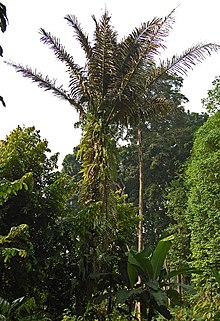Arenga pinnata
| Arenga pinnata | |
|---|---|
 |
|
| Scientific classification | |
| Kingdom: | Plantae |
| (unranked): | Angiosperms |
| (unranked): | Monocots |
| (unranked): | Commelinids |
| Order: | Arecales |
| Family: | Arecaceae |
| Genus: | Arenga |
| Species: | A. pinnata |
| Binomial name | |
|
Arenga pinnata (Wurmb) Merr. |
|
Arenga pinnata (syn. Arenga saccharifera) is an economically important feather palm native to tropical Asia, from eastern India east to Malaysia, Indonesia, and the Philippines in the east. Common names include sugar palm, arenga palm, areng palm, black-fiber palm, gomuti palm, aren, enau, irok, and kaong.
It is a medium-sized palm, growing to 20 m tall, with the trunk remaining covered by the rough old leaf bases. The leaves are 6–12 m long and 1.5 m broad, pinnate, with the pinnae in 1–6 rows, 40–70 cm long and 5 cm broad. The fruit is subglobose, 7 cm diameter, green maturing black.
It is not a threatened species, though it is locally rare in some parts of its range. It serves as an important part of the diet of several endangered species, including cloud rats of the genus Phloeomys.
The sap is harvested for commercial use in southeast Asia, yielding a sugar known in India as gur or in Indonesia as gula aren. The sap is collected and made as lahang, a traditional cold sweet drink, and is also fermented into vinegar and tuak palm wine.
Edmund Roberts talks about drinking an alcoholic beverage made in the Cavite area. He described it as a "fermented" and "intoxicating liquor." He said that it was "the pith furnished with sugar – when the liquor was properly boiled down, a farina...and of the inside of its triangular-shaped fruit a sweetbread was made."
The raw juice and pulp are caustic. This crop may develop into a major resource of biofuel (ethanol).
...
Wikipedia
